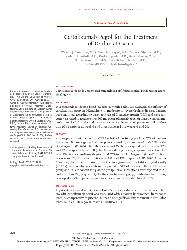Please use this identifier to cite or link to this item:
http://hdl.handle.net/11054/283Full metadata record
| DC Field | Value | Language |
|---|---|---|
| dc.contributor.author | Sandborn, William J. | en |
| dc.contributor.author | Feagan, Brian G. | en |
| dc.contributor.author | Stoinov, Simeon | en |
| dc.contributor.author | Honiball, Pieter J. | en |
| dc.contributor.author | Rutgeerts, Paul | en |
| dc.contributor.author | Mason, David | en |
| dc.contributor.author | Bloomfield, Ralph | en |
| dc.contributor.author | Schreiber, Stefan | en |
| dc.date.accessioned | 2013-05-29T07:27:55Z | en |
| dc.date.available | 2013-05-29T07:27:55Z | en |
| dc.date.issued | 2007 | en |
| dc.identifier.govdoc | 00273 | en |
| dc.identifier.issn | 0028-4793 | en |
| dc.identifier.uri | http://hdl.handle.net/11054/283 | en |
| dc.description.abstract | Background Certolizumab pegol is a pegylated humanized Fab′ fragment that binds tumor necrosis factor α. Methods In a randomized, double-blind, placebo-controlled trial, we evaluated the efficacy of certolizumab pegol in 662 adults with moderate-to-severe Crohn's disease. Patients were stratified according to baseline levels of C-reactive protein (CRP) and were randomly assigned to receive either 400 mg of certolizumab pegol or placebo subcutaneously at weeks 0, 2, and 4 and then every 4 weeks. Primary end points were the induction of a response at week 6 and a response at both weeks 6 and 26. Results Among patients with a baseline CRP level of at least 10 mg per liter, 37% of patients in the certolizumab group had a response at week 6, as compared with 26% in the placebo group (P=0.04). At both weeks 6 and 26, the corresponding values were 22% and 12%, respectively (P=0.05). In the overall population, response rates at week 6 were 35% in the certolizumab group and 27% in the placebo group (P=0.02); at both weeks 6 and 26, the response rates were 23% and 16%, respectively (P=0.02). At weeks 6 and 26, the rates of remission in the two groups did not differ significantly (P=0.17). Serious adverse events were reported in 10% of patients in the certolizumab group and 7% of those in the placebo group; serious infections were reported in 2% and less than 1%, respectively. In the certolizumab group, antibodies to the drug developed in 8% of patients, and antinuclear antibodies developed in 2%. This study was undertaken with data obtained from Ballarat Health Services - G. Phelps. | en |
| dc.description.provenance | Submitted by Gemma Siemensma (gemmas@bhs.org.au) on 2013-05-28T00:41:10Z No. of bitstreams: 0 | en |
| dc.description.provenance | Approved for entry into archive by Gemma Siemensma (gemmas@bhs.org.au) on 2013-05-29T07:27:55Z (GMT) No. of bitstreams: 1 NEJMoa067594.pdf: 229340 bytes, checksum: e4b02d75cf58e69817ef7013eb7f9d43 (MD5) | en |
| dc.description.provenance | Made available in DSpace on 2013-05-29T07:27:55Z (GMT). No. of bitstreams: 1 NEJMoa067594.pdf: 229340 bytes, checksum: e4b02d75cf58e69817ef7013eb7f9d43 (MD5) Previous issue date: 2007 | en |
| dc.publisher | Massachusetts Medical Association | en |
| dc.relation.uri | http://www.nejm.org/doi/full/10.1056/NEJMoa067594 | en |
| dc.title | Certolizumab pegol for the treatment of Crohn's disease. | en |
| dc.type | Journal Article | en |
| dc.type.specified | Article | en |
| dc.contributor.corpauthor | PRECISE 1 Study | en |
| dc.bibliographicCitation.title | New England Journal of Medicine | en |
| dc.bibliographicCitation.volume | 357 | en |
| dc.bibliographicCitation.issue | 3 | en |
| dc.bibliographicCitation.stpage | 228 | en |
| dc.bibliographicCitation.endpage | 238 | en |
| dc.publisher.place | Boston, MA. | en |
| dc.subject.healththesaurus | CROHNS DISEASE | en |
| dc.subject.healththesaurus | CERTOLIZUMAB PEGOL | en |
| dc.subject.healththesaurus | GASTROINTESTINAL | en |
| dc.subject.healththesaurus | MEDICATION | en |
| dc.subject.healththesaurus | TREATMENT | en |
| dc.subject.healththesaurus | RANDOMIZED CONTROL TRIAL | en |
| dc.date.issuedbrowse | 2007-01-01 | en |
| Appears in Collections: | Research Output | |
Files in This Item:
| File | Description | Size | Format | |
|---|---|---|---|---|
| NEJMoa067594.pdf | NEJM Sandborn et al | 223.96 kB | Adobe PDF |  View/Open |
Items in DSpace are protected by copyright, with all rights reserved, unless otherwise indicated.
